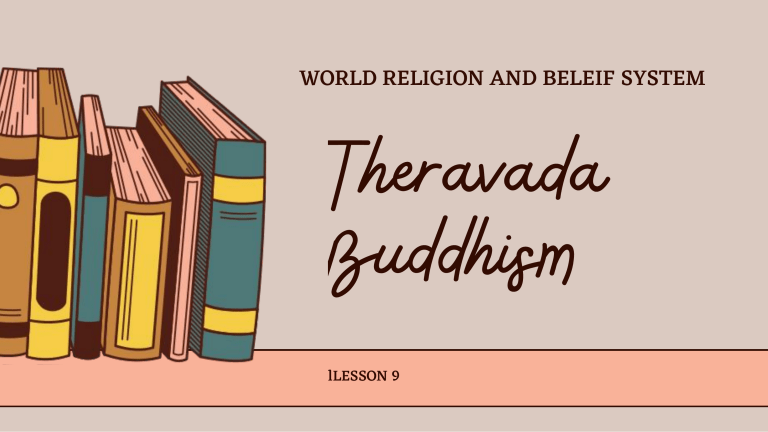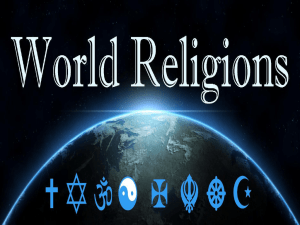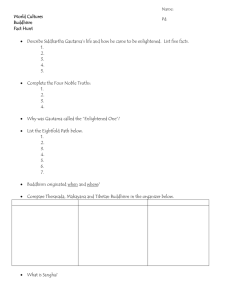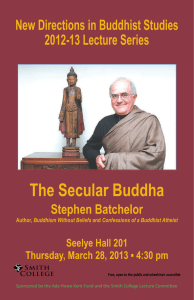English Analysing Themes and Ideas Presentation Beige Pink Lined Style
advertisement

WORLD RELIGION AND BELEIF SYSTEM lLESSON 9 Buddhism is one of the most practical among the worlds great religions because its beleif system intends to meet basic human needs and solve humankind’s spiritual problem without depending on supernatural forces (brown 1975). the two main divisions of the religion are Mahayana Buddhism and Theravada Buddhism. with around360 million followers, Mahayana Buddhism, with 150 million adherents, is followed in Myanmar, Thailand, and Sri Lanka. Buddhism is the religion of around 500 million people or about 7% to 8% of the world’s population. Asian countries that have the highest Buddhism marjority in terms of population include Cambodia (97%), Thailand (93%), Myanmar (80%), Bhutan (75%), Sri lanka (69%), and laos (66%) Buddhism has two main divisions and many sects. A major branch of the religion, Theravada Buddhism (“school of elder monks”) or “school of the ancients”) or the Southern School of Buddhism”draws on the collected teaching of siddhartha with pristine purity (clasper 1992). Theravada Buddhism has gained considered following in the west in the modern times. BUDDHIS M Sacred Scriptures Worship and Observation Beleif and Doctrines Subdivision Buddhism has been in existence for over 2,500 years and has never experienced any drastic or radical schisms in its evolution (Toula-Breysse 2001). As the disciples of Saddharta Gautama spread his word and preached throughout various communities, there came a need for them to adapt to local culture, politics, and economic context. Emerging branches of Buddhism had become adjusted to the milieu of the place. They may differ on the doctrines of Buddhism but their relationships with other subgroups are generallyi good (toula-Breysse 2001). The basic tenets of both major schools of throught orignate from Siddhartha Gautama whose life has become a constant source of inspiration to others (Brown 1975). The sage Siddhartha Gautama may have been born between 563 B.C.E to 480 B.C.E. into the Sakya tribe in lumbini (in present-day Nepal) near the town of kapilavastu (the capital city of the sakya state) in the foothills of the Nepalese himalayas (Kulananda 2001). Born into the Kshatriya case, his father was Suddhodana, an aristocratic Hindu cheiftain, and his mother was mahamaya, a koliyan princess. The buddha’s family name was Gautama or Gotama. According to tradition,at the time when Siddharta was conceived, Queen Mahamaya dreamt of a brilliant white light shining down on her from the sky. In the rays of the light was a magnificent white elephant with six large tusks. The elephant moved closer to the qeen and melted into her body. Ten months later, Siddhartha was born. He emerged from the side of the queen, took seven steps, and said “ i have been born to achieve awakening (bodhi) for the good of the world: this is my last birth (coogan 2005).” SACRED SCRIPTURES The early schools of Buddgism developed their own unique body of scared texts. Of these, however, only Pali Canon or the Tipitaka/Triptaka (“three baskets”) of Therevada Buddahisim survives (Coogan 2005). Preserved inthe Pali language, this standard collection of scriptures od Therevada Buddhisits is the first known, the most conservative, and the most complete extant early canon od Buddhist writings. immediately after siddhartha”s death or parinirvana, the “first Buddhist Council” was called to order to recite the content of his teachings or dhamma/ dharma. These teachings were initially passed down orally until they were recorded in palm trees after five centuries during the “ Fourth Buddhist Council” held in 29 B.C.E The monks saw the need to commit into writing the Pali Canon so that the monks die, important Buddhist teachings would still remain. The council was convened in Tambapanni as a result of poor harvest in Sri Lanka that starved many monks. With the support of the Sri Lakan king, recited Vattagamani of Valagamba of Anuradharpura, the council lasted for three years. Five hundred monks recited Siddhartha’s teachigs as tey recorded them in palm tress. In pali language’ the world pitaka translates as “ basket” referring to the receptacles where the palm leaf manuscripts were stored by the monks. Tipitika Contents Sutta Pitaka (Discourse) Buddha’s doctrinal; short poems to long prose narratives about Siddhartha’s previous lives Vinaya Pitaka (Displicne) Rules of disciplines; stories tat illustrate Buddhist moral principles Abhidhamma Pitaka ( ultimate Doctrine) Systematic analysis of the categories od Buddhist though The first basket, the sutta Pitaka, contains the conventional teaching delivered by Siddharta on different occasions. Discourses of Siddhartha’s disciples, such as sariputta, Moggallana, and Anada, are also part of the Sutta Pitaka. It is divided into five five collections, namely, Digha Nikaya (Collection of Long Discourses), Majjhima Nikaya (Collection of Kinded Sayings), Anguttara Nikaya (collection of Discourses arranged in accordance with number), and Kuhuddaka Nikaya (Smaller Collection). The second basket, the Vinaya Pitaka contains the displinary code required of Buddhist Monks (bhikkhus) and nuns (bhikkunis). Various rules and regulations must be followed by the monastic community.It consists of five books, namely, Parajika Pali( Major offences), Pacittiya Pali ( MInor Offences), Mahavagga Pali (Greater Section), Cullavagga Pali (Smaller Section), and Parivara Pali (Epitome of the Vinaya). The third basket, the Abhidhamma Pitaka, is a work on moral psychology. The reflective philosophies of Siddhartha’s teachings are contained in the Abhidhamma Pitaka that is strictly a Thervada collection. It is composed of seven works, namely, Dhamma-Sangani (Enumeration of Phenomena), Vibhanga (The Book of the Treatises), Katha Vattu (Point of Controversy), Puggala Pannatti (Description of Individuals), Dhatu Katha (Discussion with reference to Elements), Yamaka ( the book of pairs), and Patthana (The Book of Relations). Siddharta never intended to start a new religion especially, and so his teachings are focused primarily on ethics and self-understanding as people work fo their salvation on their own without needing the assistance of any supreme being (Hopfe 1983). Here lies the main difference of buddhism with other religions it has no place for God or savior, as salvation entirely lies within anyone’s control (Brown 1975), Siddhartha did not claim to be a savior but a guide and techer as he pointed the way others fo follow and gain spiritual bliss in doing so. Another unique feature of Buddhism is the belief that soul or the Hindu atman does not exist as people live in a state of nonsoulness or anatman/anatta. Buddhism does not preach that humans have an eneternal and indestructrible soul (Brown 1975). Human existence, or what we actually call soul, is a composite of five mental of physical aggregates or khandas. These aggregates include 1.Phycial form or corporeability 2. Feelings or sensations 3.understanding or perception 4. Will or mental formation 5. Consciousness FOUR NOBLE TRUTH 1. The Truth of Suffering 2. The Truth of the cause of Suffering 3. The Truth of the ned of suffering 4. the Truth of the path leading to the end of Suffering 1. The First Noble Truth. This identifies the origin of the problem the dukkha. Suffering can be experienced throughout the different stages of a person’s life from birth, sickness, old age, to ultimate death. When one clings to one of the previously stated aggregates, this leads to suffering, when one unites with the unpleasant, it causes suffering. When one dissociates from the pleasant, it also results in suffering. 2. The Second Noble Truth. This explaines the cause of suffering or samodaya in craving or desires (or tanha) in the perpetual thirst of humans to costume things, experience or ideas (Parrinder 1971). People are never satisfied as they always want more or something else, want something 3.The Third Truth. This asserts that there is cessation or nirodha to suffering and bondage by eliminating craving ang desire. By dropping the bonds of craving one gets to be released from the fundamental nature of reality. 4.The Fourth Noble Truth. This directs an individual to the path or magga leading to the termation of craving and desires, and to eventual cessation of pain. Likewise, one ,ust avoid selfendulgence and self-torture since both are pointless. This is the path toward moderation or the “Middle Way’’ aimed at ending suffering. Eighcfold Path Right View Right Intention Right Speech Right livelihood Right Effort Right Mindfulness Right Concertration What One Must Do Understand thr Four Noble Truths Free one’s self from ill-will, cruelty and unfulness Abstain from untruthfulness tale-bearing harsh language and van talks Earn a living a way not harmful to any living thing Avoid evil thoughts and overcome them, arouse good thoughts and main them Pay vigilant attention to every state of the body, feeling and mind. Concertrate on a single objects so as to include certain special states of consciousness in deep meditation The law od dependent origination or Pitacca-samuppada is one of the most insightful teachings of Siddharta. With everything built upon a set of relations, it follows that every effects has a define cause and every cause has a definite affect (Mizuno 1987), in short, noting comes into being by more accident and actions do not happen in a ramdom way. Both the “Four Noble Truths” and the concept of karma can be explained by dependent originations. ‘’Four Noble Truths,’’ there is the arising, that arising and cessation of the dukkha. Desire occurs because of combination od existing conditions to support its arising. Craving ends when factors supporting its presence change and end, and then no longer sustain it. Nothing in this world is fixed and permanent and everything is subject to change and alteration. Impermanence is an unavoidable fact of human existence. Buddhism affirms five processes deemed uncontrollable by any individual: old ages, sickness, dying, decay, and death. However, when one is released from samsara, a being escapes all these phenomena. That being has then reached a state called nirvana wherein desire has been extinguished from one’s self. The pali word sangha literally means”sharer” that refer to monks who share in the general fund of alms provided by a community. Translated as ‘’ association’’ or ‘’assembly,’’ sangha pertains to the Buddhist order and monastic community as founded by Siddhartha during the same year that he attained his enlightenment. Attainment of salvation for any Buddhist is by way of one’s own action without the assistance of Siddhartha as lay people offer gifts to Siddhartha and the sangha during days of worships and observance. In Buddhism, stupas are commemorative monuments that contain sacred relics associated with Sidhartha himself, and the venerable monks and nuns.



